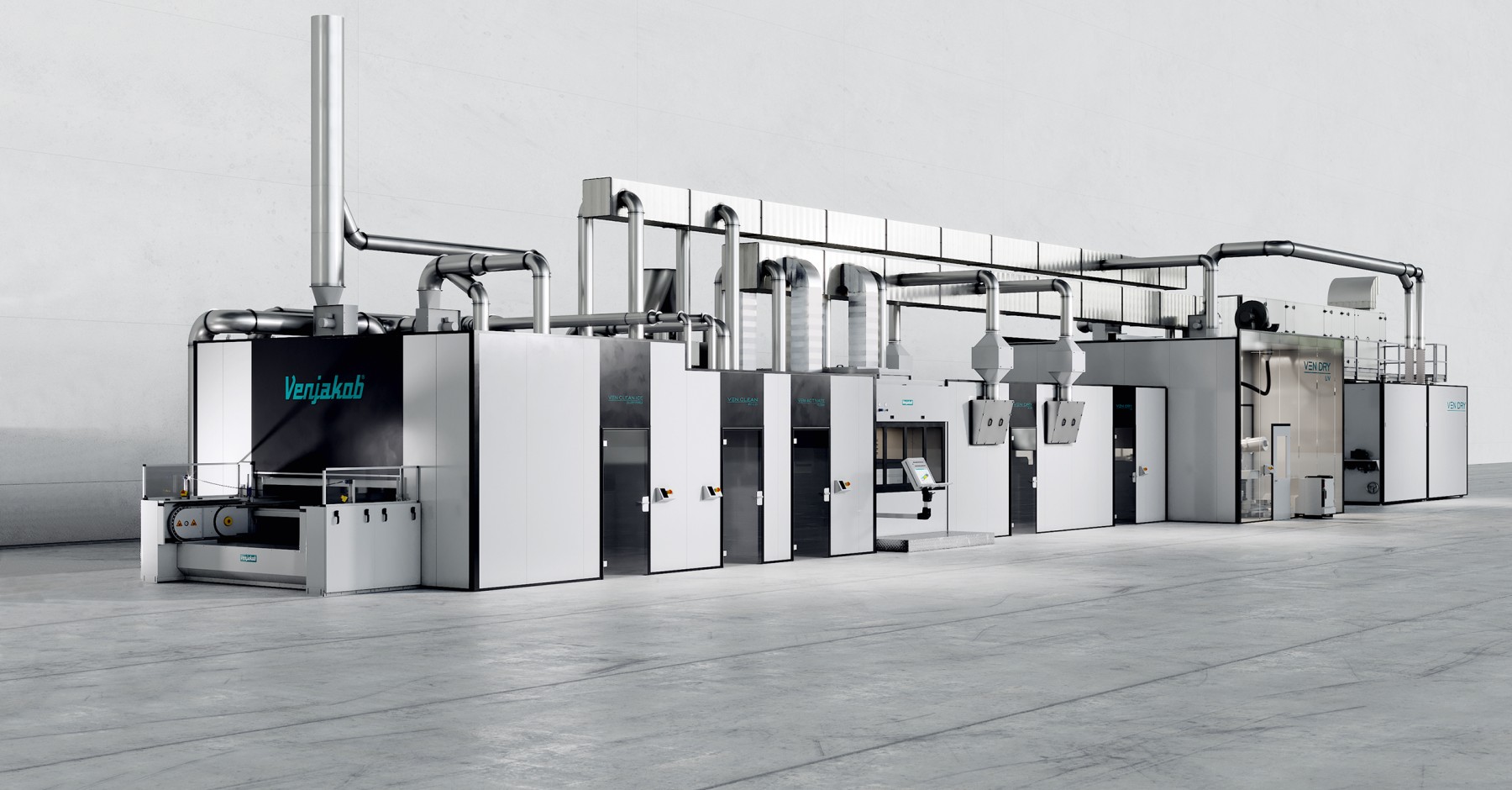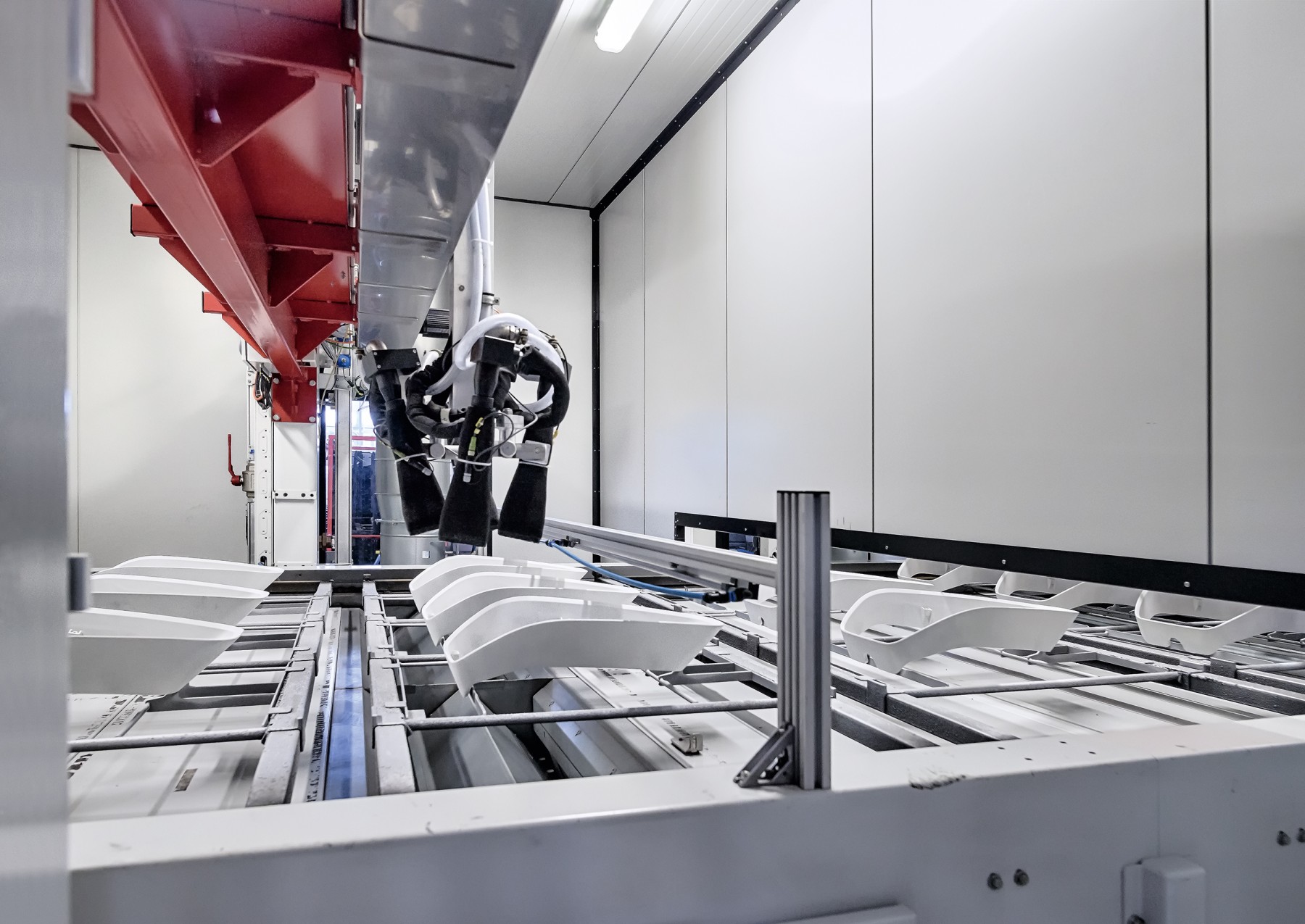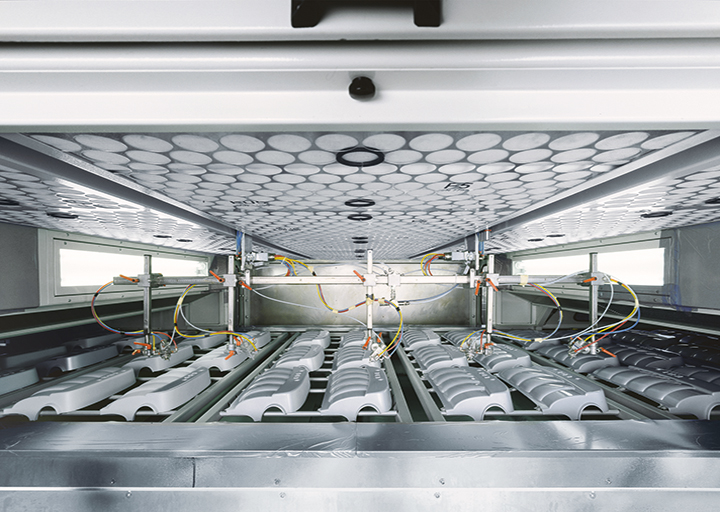Surface coating of plastic parts - Focus on time wasters
Surface coating in the industrial production of plastic components for the automotive industry, among others, is an important, possibly even the most important part of the entire production chain. A lot of money can be spent here, and just as much can be saved. Expensive paints, time-consuming machine cleaning, compliance with environmental regulations and constantly changing trends in materials and paints require technical equipment that offers the user the required flexibility and thus investment security over the years.
Overall concept with optimized individual equipment
The overall system concept for surface treatment, described here, serves as an example of what modern coating lines can achieve. Plastic parts are painted and dried using wet paint systems. The individual machines - from pre-treatment to painting and drying - were equipped with optimized individual equipment and assembled to form a complete finishing line. Traditional 1-component and 2-component solvent and water-based lacquers and UV lacquers can be used.
The complete system can be configured with the following modules:
Cleaning modules: CO2-cleaning, high-performance dedusting/ionization
Activation modules: flame, plasma, UV
Coating: Spray booth
Drying: flash off zone, infrared dryer, UV curing system, circulating air dryer, cooling zone
Fresh air supply: supply air system, full air conditioning
Exhaust air purification: exhaust air purification systems RTO, TI
Central control panel for all machines
All relevant system parameters are available via the internal plant communication system (Ethernet) and can be preselected and set via a central control panel of the machine. This enables a flexible interaction of all individual components. Each product receives its own recipe. Each colour can be prepared parallel to the running production and activated within a very short time.
High availability of the machine line
Regarding the amortization of the plant investment, Venjakob placed the focus in the planning of the production line presented here on the highest possible variability in the use of the machines used. The technical equipment was chosen accordingly. In particular, the focus was on the spray coating process. The division of the total production time into production and cleaning is typical for spray painting. Here it is determined how efficiently and profitable the plant works. The advantages of the modular design evident in the spray coating machine. Important "time robbers", such as colour changes, can be carried out simultaneously to production as quickly as possible with minimal transport downtime.
Indispensable: Machine and process data
Information about the processes, the productivity of the system as well as characteristic data documenting wear and tear are indispensable for consistent production quality, logistical planning, and plant maintenance. The advantages of process data acquisition include:
- The maintenance department is informed about necessary wear and tear work by means of the characteristic data before the plant must be stopped due to an accident.
- The production management receives reliable data on productivity and can thus meet the specified targets.
- Material flows and material requirements planning are easier within the networked information, since a need is recognized early on.
- The entire supply and discharge logistics can be flexibly planned since the productivity is known.
Process steps in surface treatment
1. Material handling
At the infeed of the machine, the components, which are on specific part skids, are placed in a horizontal position on the pallet conveyor and later removed as a finished component at the same place. If a coating on the reverse side of the workpieces is desired, an optional turning device can be installed for this purpose.
The conveyor chain of the pallet conveyor travels at a constant speed through all system components. This has been programmed specifically for the flash off drying sections to achieve the desired cure and holding times.
The advantage of this pallet conveyor is that space-saving system concepts are possible. On the one hand, this refers to the tall dryer, which uses the space in height instead of expanding in length. The pallets are transported in circulation, according to the paternoster principle.
2. The pre-treatment of the components
The upstream pre-treatment removes contamination from the workpiece surfaces by means of liquid CO2. Contact free. Downstream follows a high-performance de-dusting/ionization unit with consumption-optimized, rotating blow-off nozzles. The raised particles are removed by an efficient suction system. Cleaning is followed by neutralization of the static surface charge of the workpieces by means of an ionizing system. The workpieces leave the pre-treatment in a clean and charge-neutral condition.
3. The activation of the components
A surface activation for better wettability by flame, plasma or UV could be a next step in pre-treatment. The above mentioned processes increase the quality of the haptics and optimally prepare the plastic workpieces for the absorption of the coating material.
4. spray painting
The spray coating machine conveys the workpieces on work piece carriers beneath the spray guns, which are moving crossways to the running direction. Paint is applied in a continuous flow without stopping. The machine can be equipped with an automatic colour change system. In interaction with the higher-level system control, the colour change takes place automatically.
The supply lines between the system and the spray guns have been kept short to avoid unnecessary paint losses during rinsing. The Venjakob colour management system also ensures shorter set-up times and reduced consumption of solvents.
A suction system adapted to the application, in combination with a sophisticated fresh air supply, enables optimum removal of the resulting overspray. The workpieces are detected on the inlet side by a workpiece scanner and the machine control system generates a consumption-optimised spray-painting program for each installed spray gun.
5. Drying process
The subsequent flash-off zone is designed lengthwise for the painting process and the related coating speed. It is also possible to integrate infrared drying into the flash-off zone. Furthermore, a UV curing system can be added downstream, using a robot that moves at right angles to the conveying direction. The following circulating air dryer is designed for six levels and is easily accessible for cleaning and maintenance purposes by means of movable dryer elements. The drying time and the related size (length) of the dryer is adapted to the painting process. There is a cooling zone below the system. There the components are conveyed back to the infeed of the coating line. Optimal evaporation, drying, curing, or cooling are important process steps when it comes to achieving a high surface quality.
6. Fresh air supply
The supply of fresh air is independent of the production facility. The supply air systems suck in air from outside, filter, heat, and humidify it according to the climatic conditions of the paint systems to be processed. At some locations and when using miscellaneous lacquer systems, full air-conditioning of the supply air is a prerequisite for maintaining constant climatic conditions during coating all year round. The full air-conditioning can be integrated into the supply air system at any time.
7. exhaust air cleaning
The purification of organic solvents from the exhaust air of the entire system is ensured by an exhaust air purification technology from Venjakob Umwelttechnik. This is adjusted and designed to suit the solvent consumption and the exhaust air volume. Different technologies such as regenerative thermal oxidizers and thermal oxidizers are used here, if necessary, in combination with a concentration rotor. In this way, the strict limit values of the international air treatment guidelines, such as the European VOC, can be complied with.




